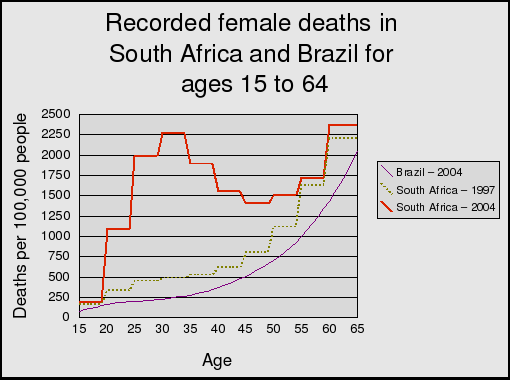This is an archive of the Treatment Action Campaign's public documents from
December 1998 until October 2008. I created this website because the TAC's
website appears unmaintained and people were concerned that it
was becoming
increasingly hard to find important documents.
The menu items have
been slightly edited and a new stylesheet applied to the site. But none of the
documents have been edited, not even for minor errors. The text appears on this
site as obtained from the Internet Archive.
The period covered by
the archive encompassed the campaign for HIV medicines, the civil disobedience
campaigns, the Competition Commission complaints, the 2008 xenophobic violence
and the PMTCT, Khayelitsha health workers and Matthias Rath court cases.

Constructed using mortality data from Statistics South Africa and Instituto Basileiro de
Geografia e Estatística.
The graph above shows the effect of AIDS on adult female deaths in South Africa. Note how deaths in South Africa have risen between 1997 and 2004. More importantly, note how the age-pattern of deaths has changed. Not shown in this graph is that by 2000, the absolute number of South Africans dying in their 30s and 40s exceeded those dying in their 60s and 70s. The graph shows that by 2004, the proportion of female South Africans dying between the ages of 30 to 34 was almost the same as those dying between the ages of 60 to 64.
The Brazilian mortality graph is what one would expect to see in the absence of AIDS. South Africa has a higher per capita GDP than Brazil and similar levels of inequality. Yet Brazilians have much higher life-expectancy. The only plausible reason is this: less than 1% of Brazilians have HIV versus more than 10% of South Africans. Also, Brazil began implementing a policy of universal treatment for people with HIV in 1997. South Africa only began implementing its programme of universal access to treatment in 2004. In 2006, most people who need treatment still cannot access it.